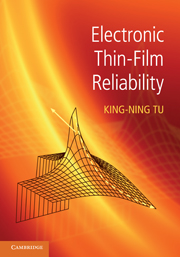Book contents
- Frontmatter
- Dedication
- Contents
- Preface
- 1 Thin-film applications to microelectronic technology
- 2 Thin-film deposition
- 3 Surface energies
- 4 Atomic diffusion in solids
- 5 Applications of the diffusion equation
- 6 Elastic stress and strain in thin films
- 7 Surface kinetic processes on thin films
- 8 Interdiffusion and reaction in thin films
- 9 Grain-boundary diffusion
- 10 Irreversible processes in interconnect and packaging technology
- 11 Electromigration in metals
- 12 Electromigration-induced failure in Al and Cu interconnects
- 13 Thermomigration
- 14 Stress migration in thin films
- 15 Reliability science and analysis
- Appendix A A brief review of thermodynamic functions
- Appendix B Defect concentration in solids
- Appendix C Derivation of Huntington's electron wind force
- Appendix D Elastic constants tables and conversions
- Appendix E Terrace size distribution in Si MBE
- Appendix F Interdiffusion coefficient
- Appendix G Tables of physical properties
- Index
- References
10 - Irreversible processes in interconnect and packaging technology
Published online by Cambridge University Press: 05 July 2014
- Frontmatter
- Dedication
- Contents
- Preface
- 1 Thin-film applications to microelectronic technology
- 2 Thin-film deposition
- 3 Surface energies
- 4 Atomic diffusion in solids
- 5 Applications of the diffusion equation
- 6 Elastic stress and strain in thin films
- 7 Surface kinetic processes on thin films
- 8 Interdiffusion and reaction in thin films
- 9 Grain-boundary diffusion
- 10 Irreversible processes in interconnect and packaging technology
- 11 Electromigration in metals
- 12 Electromigration-induced failure in Al and Cu interconnects
- 13 Thermomigration
- 14 Stress migration in thin films
- 15 Reliability science and analysis
- Appendix A A brief review of thermodynamic functions
- Appendix B Defect concentration in solids
- Appendix C Derivation of Huntington's electron wind force
- Appendix D Elastic constants tables and conversions
- Appendix E Terrace size distribution in Si MBE
- Appendix F Interdiffusion coefficient
- Appendix G Tables of physical properties
- Index
- References
Summary
Introduction
Thin-film materials science is wafer-based and flux-driven. Up to now, most thin-film applications occur on devices built on semiconductor wafers. To process a microelectronic or opto-electronic device, the basic step consists of adding a monolayer of atoms on or subtracting it from a wafer surface. In these processes, we are not dealing with equilibrium states of materials; rather, we deal with kinetic states of a flux of atoms. Furthermore, for example, a p-n junction in a semiconductor is not at an equilibrium state. If we anneal the junction at a high temperature for a long time, it will disappear by interdiffusion of the p-type and n-type dopants. At device operation near room temperature, the dopants are supersaturated and frozen in place in the semiconductor to produce the electrical potentials, the built-in potentials, needed to guide the transport of charges. In doping a semiconductor, we need to diffuse or to implant a flux of atoms into the semiconductor to obtain the desired concentration profile of dopant. In device operation based on field effects, we pass an electric current or a flow of charge particles through the device to turn on or turn off the FETs. Thus, we consider flux-driven processes.
Generally speaking, we can have a flux or a flow of matter, a flow of energy (heat), or a flow of charge particles in a system. Indeed, in electronic devices, the operation can have all three kinds of flow coexist in the devices.
- Type
- Chapter
- Information
- Electronic Thin-Film Reliability , pp. 212 - 236Publisher: Cambridge University PressPrint publication year: 2010

